Risk Management Report: Risk Management and Business Strategies
VerifiedAdded on 2021/04/17
|12
|2685
|25
Report
AI Summary
This report delves into the multifaceted realm of risk management within a business context. It begins by defining risk as an integral part of business operations, highlighting the necessity for organizations to implement innovative strategies while acknowledging the potential for both positive and negative outcomes. The report emphasizes the importance of effective risk management in identifying strengths and weaknesses of strategies, implementing alternative plans, and ultimately achieving organizational goals. It then explores loss prevention, detailing strategies such as budget adjustments, technology adoption, and pricing adjustments. The report also examines various risk management tools and techniques, including documentation reviews, information gathering, brainstorming, SWOT analysis, and checklist analysis. Furthermore, it analyzes the limitations and drawbacks associated with implementing these techniques. Finally, the report concludes by discussing the features of loss prevention arrangements, emphasizing the significance of time-bound strategies and the potential impact of pricing adjustments on customer perception and sales volume.
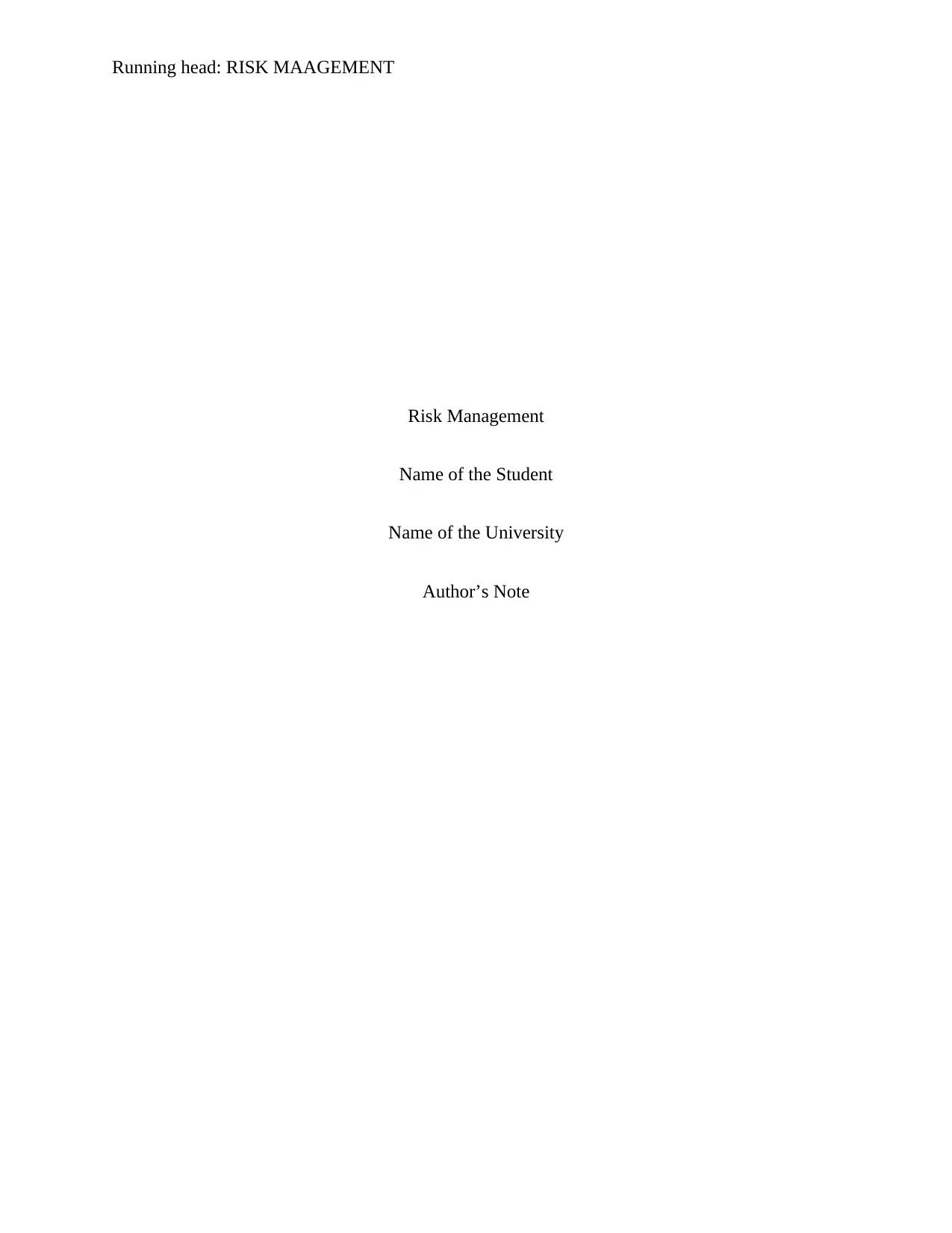
Running head: RISK MAAGEMENT
Risk Management
Name of the Student
Name of the University
Author’s Note
Risk Management
Name of the Student
Name of the University
Author’s Note
Paraphrase This Document
Need a fresh take? Get an instant paraphrase of this document with our AI Paraphraser
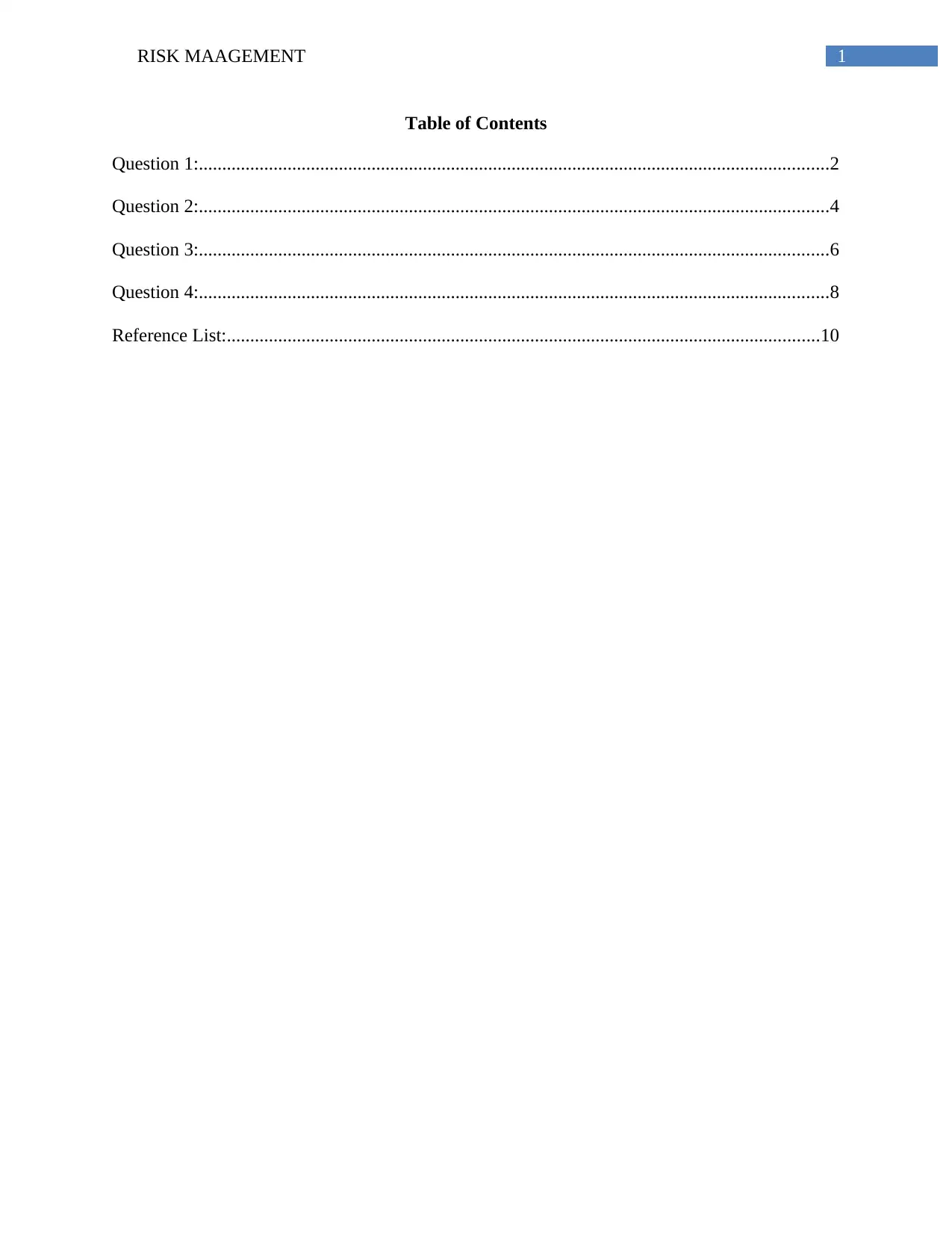
1RISK MAAGEMENT
Table of Contents
Question 1:.......................................................................................................................................2
Question 2:.......................................................................................................................................4
Question 3:.......................................................................................................................................6
Question 4:.......................................................................................................................................8
Reference List:...............................................................................................................................10
Table of Contents
Question 1:.......................................................................................................................................2
Question 2:.......................................................................................................................................4
Question 3:.......................................................................................................................................6
Question 4:.......................................................................................................................................8
Reference List:...............................................................................................................................10
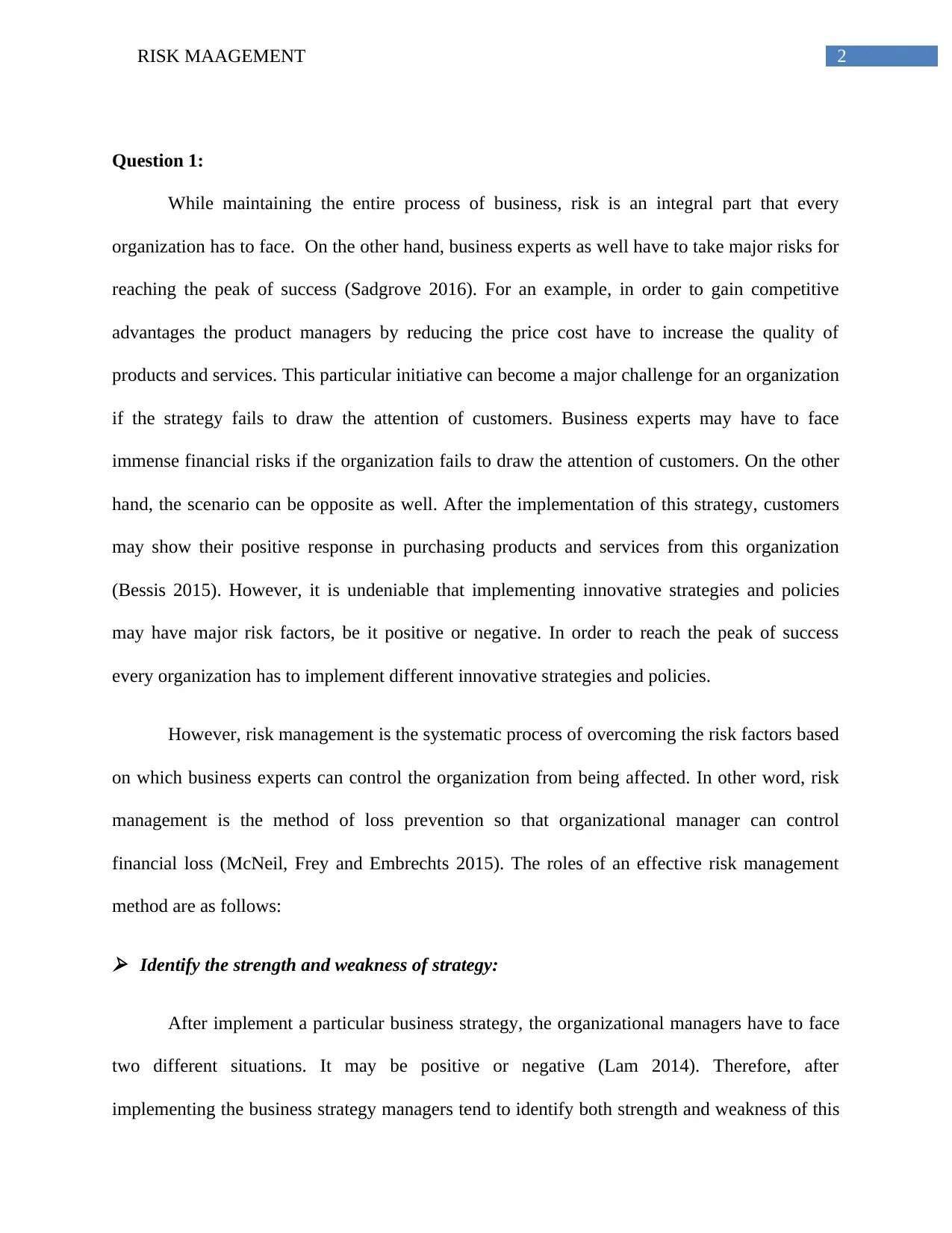
2RISK MAAGEMENT
Question 1:
While maintaining the entire process of business, risk is an integral part that every
organization has to face. On the other hand, business experts as well have to take major risks for
reaching the peak of success (Sadgrove 2016). For an example, in order to gain competitive
advantages the product managers by reducing the price cost have to increase the quality of
products and services. This particular initiative can become a major challenge for an organization
if the strategy fails to draw the attention of customers. Business experts may have to face
immense financial risks if the organization fails to draw the attention of customers. On the other
hand, the scenario can be opposite as well. After the implementation of this strategy, customers
may show their positive response in purchasing products and services from this organization
(Bessis 2015). However, it is undeniable that implementing innovative strategies and policies
may have major risk factors, be it positive or negative. In order to reach the peak of success
every organization has to implement different innovative strategies and policies.
However, risk management is the systematic process of overcoming the risk factors based
on which business experts can control the organization from being affected. In other word, risk
management is the method of loss prevention so that organizational manager can control
financial loss (McNeil, Frey and Embrechts 2015). The roles of an effective risk management
method are as follows:
Identify the strength and weakness of strategy:
After implement a particular business strategy, the organizational managers have to face
two different situations. It may be positive or negative (Lam 2014). Therefore, after
implementing the business strategy managers tend to identify both strength and weakness of this
Question 1:
While maintaining the entire process of business, risk is an integral part that every
organization has to face. On the other hand, business experts as well have to take major risks for
reaching the peak of success (Sadgrove 2016). For an example, in order to gain competitive
advantages the product managers by reducing the price cost have to increase the quality of
products and services. This particular initiative can become a major challenge for an organization
if the strategy fails to draw the attention of customers. Business experts may have to face
immense financial risks if the organization fails to draw the attention of customers. On the other
hand, the scenario can be opposite as well. After the implementation of this strategy, customers
may show their positive response in purchasing products and services from this organization
(Bessis 2015). However, it is undeniable that implementing innovative strategies and policies
may have major risk factors, be it positive or negative. In order to reach the peak of success
every organization has to implement different innovative strategies and policies.
However, risk management is the systematic process of overcoming the risk factors based
on which business experts can control the organization from being affected. In other word, risk
management is the method of loss prevention so that organizational manager can control
financial loss (McNeil, Frey and Embrechts 2015). The roles of an effective risk management
method are as follows:
Identify the strength and weakness of strategy:
After implement a particular business strategy, the organizational managers have to face
two different situations. It may be positive or negative (Lam 2014). Therefore, after
implementing the business strategy managers tend to identify both strength and weakness of this
⊘ This is a preview!⊘
Do you want full access?
Subscribe today to unlock all pages.

Trusted by 1+ million students worldwide

3RISK MAAGEMENT
business policy. As a result, the business experts can get a prediction about negative
consequences.
Helps to implement alternative strategy and policy:
In case of overcoming the negative consequences, the organizational manager intends to
focus on implementing alternative strategies as well. If one particular business strategy fails to
draw the attention of customers, the organization likes to implement alternative strategies as
well. As a result, effect of risk factors can be measured. For an example, after the incident of
Brexit large numbers of employees intended to leave the organizations of UK due to the lack of
job security (Fadun 2013). In this situation, the business organizations belonging to UK has
decided to increase the rate of employee remuneration to overcome this kind of crisis. Therefore,
alternative strategy is highly significant for overcoming any kind of business risks and
uncertainties.
Reaches organizational goal:
Risk being a part of business should be dealt with intellectually so that business experts
can easily overcome. However, risk management is one of the most effective measure based on
which the organization can reach the peak of success (Kozubíková et al. 2013). On the other
hand, risk management system helps the employees to provide their best endeavor towards the
services. As a result, the organization can share a good bond between service providers and
service users.
business policy. As a result, the business experts can get a prediction about negative
consequences.
Helps to implement alternative strategy and policy:
In case of overcoming the negative consequences, the organizational manager intends to
focus on implementing alternative strategies as well. If one particular business strategy fails to
draw the attention of customers, the organization likes to implement alternative strategies as
well. As a result, effect of risk factors can be measured. For an example, after the incident of
Brexit large numbers of employees intended to leave the organizations of UK due to the lack of
job security (Fadun 2013). In this situation, the business organizations belonging to UK has
decided to increase the rate of employee remuneration to overcome this kind of crisis. Therefore,
alternative strategy is highly significant for overcoming any kind of business risks and
uncertainties.
Reaches organizational goal:
Risk being a part of business should be dealt with intellectually so that business experts
can easily overcome. However, risk management is one of the most effective measure based on
which the organization can reach the peak of success (Kozubíková et al. 2013). On the other
hand, risk management system helps the employees to provide their best endeavor towards the
services. As a result, the organization can share a good bond between service providers and
service users.
Paraphrase This Document
Need a fresh take? Get an instant paraphrase of this document with our AI Paraphraser
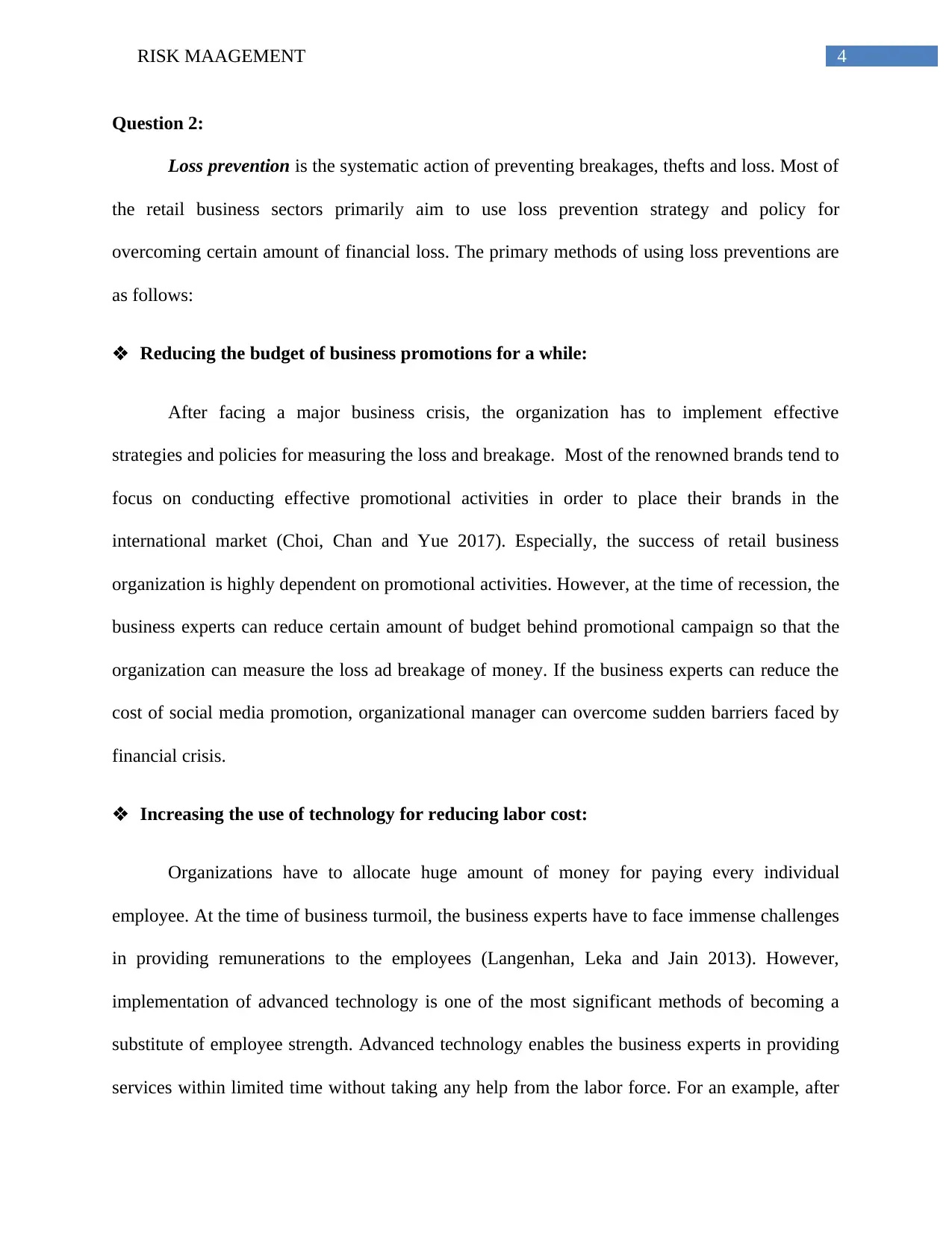
4RISK MAAGEMENT
Question 2:
Loss prevention is the systematic action of preventing breakages, thefts and loss. Most of
the retail business sectors primarily aim to use loss prevention strategy and policy for
overcoming certain amount of financial loss. The primary methods of using loss preventions are
as follows:
Reducing the budget of business promotions for a while:
After facing a major business crisis, the organization has to implement effective
strategies and policies for measuring the loss and breakage. Most of the renowned brands tend to
focus on conducting effective promotional activities in order to place their brands in the
international market (Choi, Chan and Yue 2017). Especially, the success of retail business
organization is highly dependent on promotional activities. However, at the time of recession, the
business experts can reduce certain amount of budget behind promotional campaign so that the
organization can measure the loss ad breakage of money. If the business experts can reduce the
cost of social media promotion, organizational manager can overcome sudden barriers faced by
financial crisis.
Increasing the use of technology for reducing labor cost:
Organizations have to allocate huge amount of money for paying every individual
employee. At the time of business turmoil, the business experts have to face immense challenges
in providing remunerations to the employees (Langenhan, Leka and Jain 2013). However,
implementation of advanced technology is one of the most significant methods of becoming a
substitute of employee strength. Advanced technology enables the business experts in providing
services within limited time without taking any help from the labor force. For an example, after
Question 2:
Loss prevention is the systematic action of preventing breakages, thefts and loss. Most of
the retail business sectors primarily aim to use loss prevention strategy and policy for
overcoming certain amount of financial loss. The primary methods of using loss preventions are
as follows:
Reducing the budget of business promotions for a while:
After facing a major business crisis, the organization has to implement effective
strategies and policies for measuring the loss and breakage. Most of the renowned brands tend to
focus on conducting effective promotional activities in order to place their brands in the
international market (Choi, Chan and Yue 2017). Especially, the success of retail business
organization is highly dependent on promotional activities. However, at the time of recession, the
business experts can reduce certain amount of budget behind promotional campaign so that the
organization can measure the loss ad breakage of money. If the business experts can reduce the
cost of social media promotion, organizational manager can overcome sudden barriers faced by
financial crisis.
Increasing the use of technology for reducing labor cost:
Organizations have to allocate huge amount of money for paying every individual
employee. At the time of business turmoil, the business experts have to face immense challenges
in providing remunerations to the employees (Langenhan, Leka and Jain 2013). However,
implementation of advanced technology is one of the most significant methods of becoming a
substitute of employee strength. Advanced technology enables the business experts in providing
services within limited time without taking any help from the labor force. For an example, after

5RISK MAAGEMENT
the emergence of barbecued oven the restaurants do not have to invest sufficient money for chef.
In addition, purchasing a technology is one time investment for the business experts with the
help of which they can save huge amount of money in future (Chance and Brooks 2015). As a
result, the organization does not have to pay remuneration in every single month.
Increasing the price of existing products:
In order to measure the immediate loss faced by the company organizations have to
increase the price level of products. As a result, the business experts would be able to recover the
breakage loss of money. Increasing the price cost behind every product would help the
organization to regain business image and reputation.
However, the methods used for loss preventions are constituted with major limitations as
well. Increasing product price is constituted with negative impacts as well. Customers may show
a negative impression in purchasing products in high price level. As a result, risk managers may
have to face difficulties in implementing this particular method effectively (Wolke 2017). On the
other hand, in order to implement technological devices within the organization, the business
experts have to invest huge amount of money at a time. Economic barrier is one of the most
significant reasons due to which companies have to face immense difficulties in investing huge
amount of money for rendering technological devises within the business process. On the other
hand, business promotion is one of the most effective ways of success (Dionne 2013). If the
business experts tend to reduce their budget behind promotional activities, the entire
organizational image may get affected.
the emergence of barbecued oven the restaurants do not have to invest sufficient money for chef.
In addition, purchasing a technology is one time investment for the business experts with the
help of which they can save huge amount of money in future (Chance and Brooks 2015). As a
result, the organization does not have to pay remuneration in every single month.
Increasing the price of existing products:
In order to measure the immediate loss faced by the company organizations have to
increase the price level of products. As a result, the business experts would be able to recover the
breakage loss of money. Increasing the price cost behind every product would help the
organization to regain business image and reputation.
However, the methods used for loss preventions are constituted with major limitations as
well. Increasing product price is constituted with negative impacts as well. Customers may show
a negative impression in purchasing products in high price level. As a result, risk managers may
have to face difficulties in implementing this particular method effectively (Wolke 2017). On the
other hand, in order to implement technological devices within the organization, the business
experts have to invest huge amount of money at a time. Economic barrier is one of the most
significant reasons due to which companies have to face immense difficulties in investing huge
amount of money for rendering technological devises within the business process. On the other
hand, business promotion is one of the most effective ways of success (Dionne 2013). If the
business experts tend to reduce their budget behind promotional activities, the entire
organizational image may get affected.
⊘ This is a preview!⊘
Do you want full access?
Subscribe today to unlock all pages.

Trusted by 1+ million students worldwide

6RISK MAAGEMENT
Question 3:
In order to manage the risk factors business experts can focus on implementing risk
management tools and technique. Based on these risk management technique the managers can
identify the areas of uncertainties and its systematic methods to overcome. The necessary tools
used for risk management are as follows:
Documentation Reviews:
Documentation review is the legal procedure that every business organization has to
follow while running their entire process of business (Glendon, Clarke and McKenna 2016).
Before purchasing raw materials from the suppliers, the business experts have to review every
documentation properly. In addition, while providing government taxes the organization has to
maintain documentation properly to avoid any kind of risk factors.
Information Gathering Techniques:
With the help of advanced technology, organization should maintain chronological data
everywhere. From human resource department to finance department every single department
should focus on maintaining proper data and information (Pritchard and PMP 2014). The
marketing executives should gather time-to-time customers’ feedback as well in order to avoid
any kind of risk factors. Customers’ feedback helps an organization to get an in-depth overview
about their current needs and demands
Brainstorming
Question 3:
In order to manage the risk factors business experts can focus on implementing risk
management tools and technique. Based on these risk management technique the managers can
identify the areas of uncertainties and its systematic methods to overcome. The necessary tools
used for risk management are as follows:
Documentation Reviews:
Documentation review is the legal procedure that every business organization has to
follow while running their entire process of business (Glendon, Clarke and McKenna 2016).
Before purchasing raw materials from the suppliers, the business experts have to review every
documentation properly. In addition, while providing government taxes the organization has to
maintain documentation properly to avoid any kind of risk factors.
Information Gathering Techniques:
With the help of advanced technology, organization should maintain chronological data
everywhere. From human resource department to finance department every single department
should focus on maintaining proper data and information (Pritchard and PMP 2014). The
marketing executives should gather time-to-time customers’ feedback as well in order to avoid
any kind of risk factors. Customers’ feedback helps an organization to get an in-depth overview
about their current needs and demands
Brainstorming
Paraphrase This Document
Need a fresh take? Get an instant paraphrase of this document with our AI Paraphraser
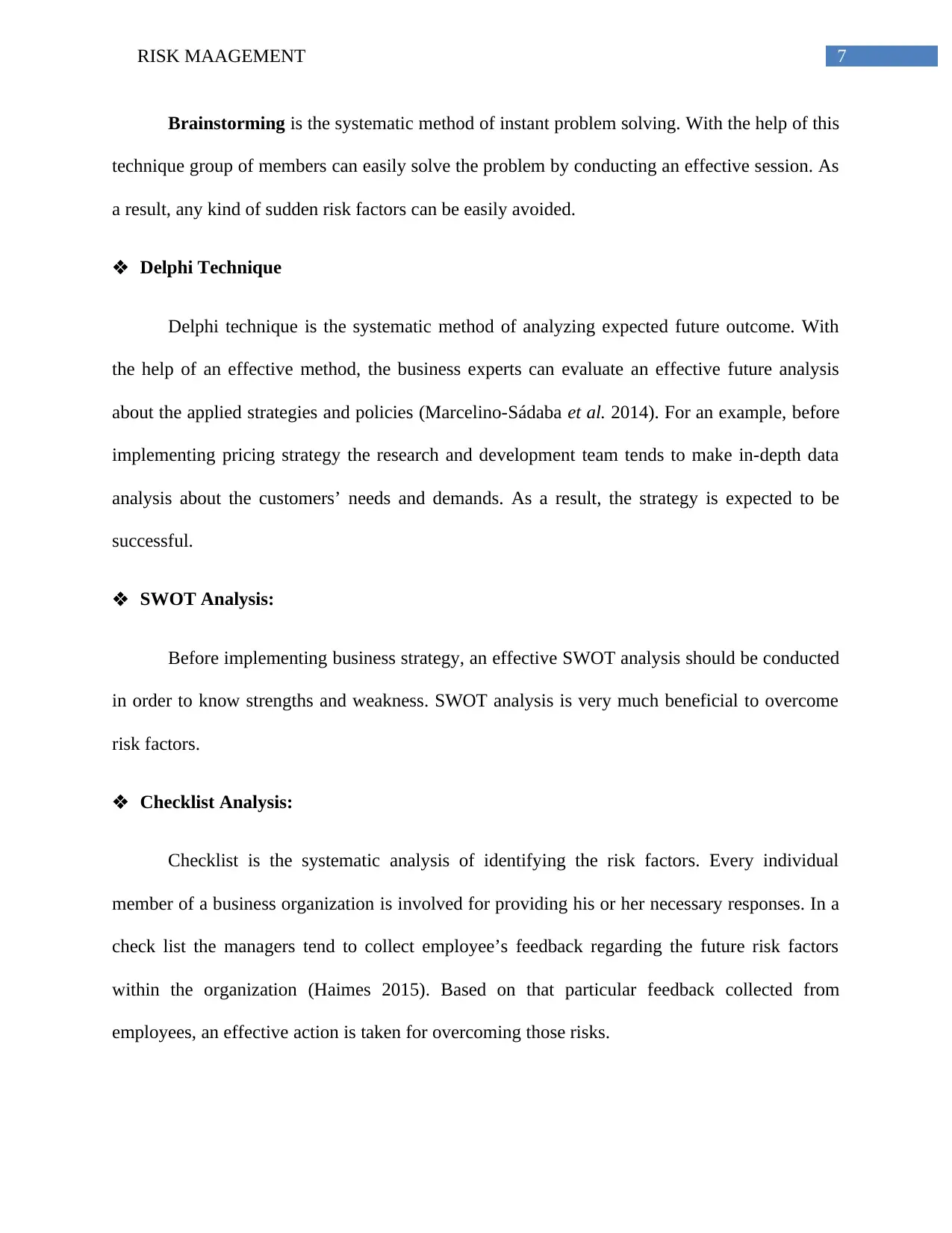
7RISK MAAGEMENT
Brainstorming is the systematic method of instant problem solving. With the help of this
technique group of members can easily solve the problem by conducting an effective session. As
a result, any kind of sudden risk factors can be easily avoided.
Delphi Technique
Delphi technique is the systematic method of analyzing expected future outcome. With
the help of an effective method, the business experts can evaluate an effective future analysis
about the applied strategies and policies (Marcelino-Sádaba et al. 2014). For an example, before
implementing pricing strategy the research and development team tends to make in-depth data
analysis about the customers’ needs and demands. As a result, the strategy is expected to be
successful.
SWOT Analysis:
Before implementing business strategy, an effective SWOT analysis should be conducted
in order to know strengths and weakness. SWOT analysis is very much beneficial to overcome
risk factors.
Checklist Analysis:
Checklist is the systematic analysis of identifying the risk factors. Every individual
member of a business organization is involved for providing his or her necessary responses. In a
check list the managers tend to collect employee’s feedback regarding the future risk factors
within the organization (Haimes 2015). Based on that particular feedback collected from
employees, an effective action is taken for overcoming those risks.
Brainstorming is the systematic method of instant problem solving. With the help of this
technique group of members can easily solve the problem by conducting an effective session. As
a result, any kind of sudden risk factors can be easily avoided.
Delphi Technique
Delphi technique is the systematic method of analyzing expected future outcome. With
the help of an effective method, the business experts can evaluate an effective future analysis
about the applied strategies and policies (Marcelino-Sádaba et al. 2014). For an example, before
implementing pricing strategy the research and development team tends to make in-depth data
analysis about the customers’ needs and demands. As a result, the strategy is expected to be
successful.
SWOT Analysis:
Before implementing business strategy, an effective SWOT analysis should be conducted
in order to know strengths and weakness. SWOT analysis is very much beneficial to overcome
risk factors.
Checklist Analysis:
Checklist is the systematic analysis of identifying the risk factors. Every individual
member of a business organization is involved for providing his or her necessary responses. In a
check list the managers tend to collect employee’s feedback regarding the future risk factors
within the organization (Haimes 2015). Based on that particular feedback collected from
employees, an effective action is taken for overcoming those risks.
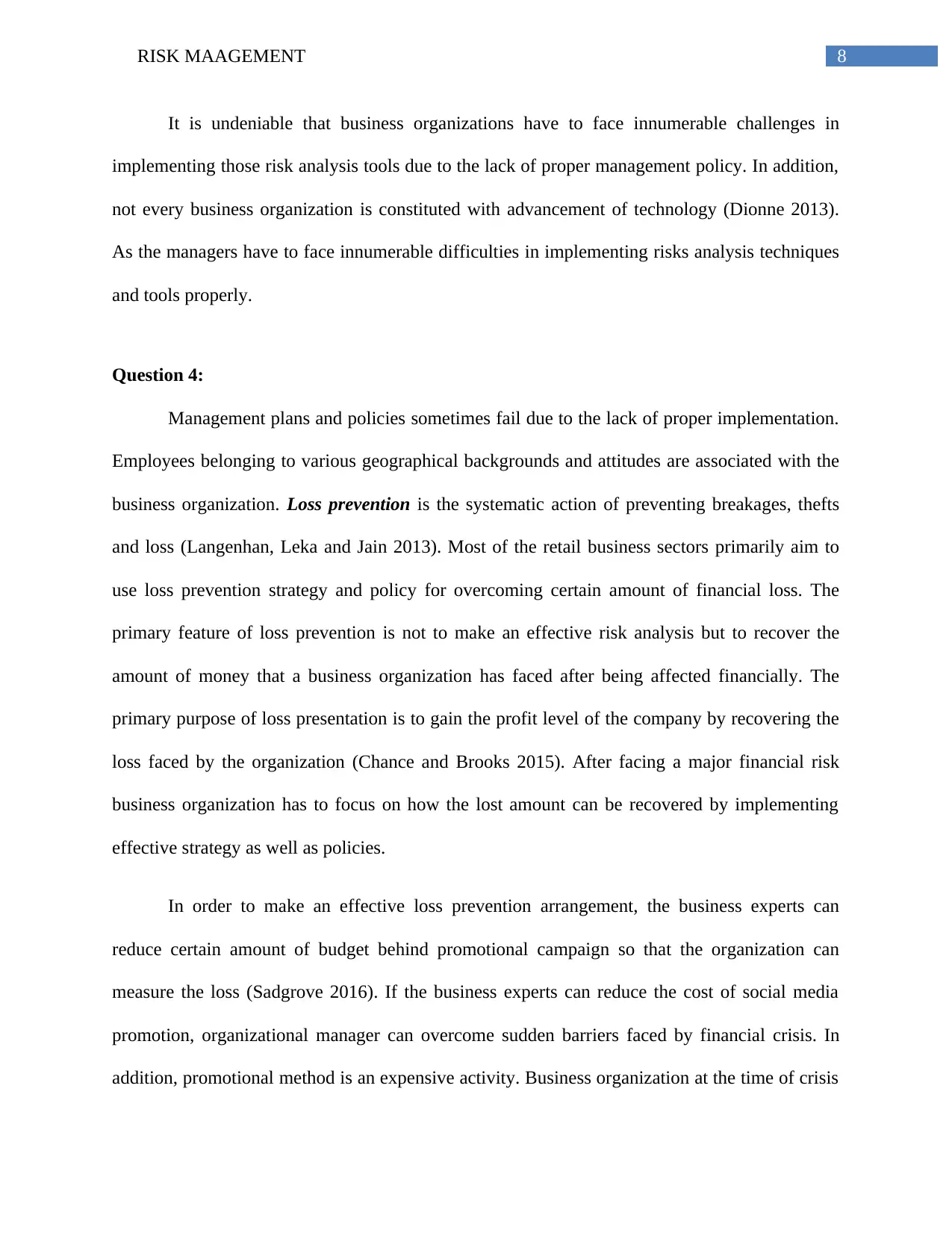
8RISK MAAGEMENT
It is undeniable that business organizations have to face innumerable challenges in
implementing those risk analysis tools due to the lack of proper management policy. In addition,
not every business organization is constituted with advancement of technology (Dionne 2013).
As the managers have to face innumerable difficulties in implementing risks analysis techniques
and tools properly.
Question 4:
Management plans and policies sometimes fail due to the lack of proper implementation.
Employees belonging to various geographical backgrounds and attitudes are associated with the
business organization. Loss prevention is the systematic action of preventing breakages, thefts
and loss (Langenhan, Leka and Jain 2013). Most of the retail business sectors primarily aim to
use loss prevention strategy and policy for overcoming certain amount of financial loss. The
primary feature of loss prevention is not to make an effective risk analysis but to recover the
amount of money that a business organization has faced after being affected financially. The
primary purpose of loss presentation is to gain the profit level of the company by recovering the
loss faced by the organization (Chance and Brooks 2015). After facing a major financial risk
business organization has to focus on how the lost amount can be recovered by implementing
effective strategy as well as policies.
In order to make an effective loss prevention arrangement, the business experts can
reduce certain amount of budget behind promotional campaign so that the organization can
measure the loss (Sadgrove 2016). If the business experts can reduce the cost of social media
promotion, organizational manager can overcome sudden barriers faced by financial crisis. In
addition, promotional method is an expensive activity. Business organization at the time of crisis
It is undeniable that business organizations have to face innumerable challenges in
implementing those risk analysis tools due to the lack of proper management policy. In addition,
not every business organization is constituted with advancement of technology (Dionne 2013).
As the managers have to face innumerable difficulties in implementing risks analysis techniques
and tools properly.
Question 4:
Management plans and policies sometimes fail due to the lack of proper implementation.
Employees belonging to various geographical backgrounds and attitudes are associated with the
business organization. Loss prevention is the systematic action of preventing breakages, thefts
and loss (Langenhan, Leka and Jain 2013). Most of the retail business sectors primarily aim to
use loss prevention strategy and policy for overcoming certain amount of financial loss. The
primary feature of loss prevention is not to make an effective risk analysis but to recover the
amount of money that a business organization has faced after being affected financially. The
primary purpose of loss presentation is to gain the profit level of the company by recovering the
loss faced by the organization (Chance and Brooks 2015). After facing a major financial risk
business organization has to focus on how the lost amount can be recovered by implementing
effective strategy as well as policies.
In order to make an effective loss prevention arrangement, the business experts can
reduce certain amount of budget behind promotional campaign so that the organization can
measure the loss (Sadgrove 2016). If the business experts can reduce the cost of social media
promotion, organizational manager can overcome sudden barriers faced by financial crisis. In
addition, promotional method is an expensive activity. Business organization at the time of crisis
⊘ This is a preview!⊘
Do you want full access?
Subscribe today to unlock all pages.

Trusted by 1+ million students worldwide

9RISK MAAGEMENT
has to face innumerable challenges in allocating their budget for promotional purposes.
However, reducing promotional cost is one of the most effective ways of overcoming risk and
preventing loss in the entire process of business.
One of the most significant methods of loss prevention method is time period. This
particular method has to be implemented for a while. Business organization has to face this kind
of financial crisis for a certain period (Lam 2014). As a result, both the business experts and the
customers have to implement different policies and strategies for certain period. In order to
measure the immediate loss faced by the company organizations have to increase the price level
of products. As a result, the business experts would be able to recover the breakage loss of
money (Fadun 2013). Increasing the price cost behind every product would help the organization
to regain business image and reputation.
After evaluating the features of loss prevention arrangement it can be concluded that this
particular technique is constituted with major drawbacks. In order to prevent the loss factors
organization increases the price of products that resulted a negative impact on the overall
impression of the customers. Sudden inflation on product may not give a positive impact on
overcoming the entire crisis. As a result, customers may show their reluctant attitude in being the
part of services. In addition, if the sales volume is decreased due to the price hike the entire
business process has to face challenges in maintaining their sustainability. Moreover, in order to
implement technological devices within the organization, the business experts have to invest
huge amount of money at a time.
has to face innumerable challenges in allocating their budget for promotional purposes.
However, reducing promotional cost is one of the most effective ways of overcoming risk and
preventing loss in the entire process of business.
One of the most significant methods of loss prevention method is time period. This
particular method has to be implemented for a while. Business organization has to face this kind
of financial crisis for a certain period (Lam 2014). As a result, both the business experts and the
customers have to implement different policies and strategies for certain period. In order to
measure the immediate loss faced by the company organizations have to increase the price level
of products. As a result, the business experts would be able to recover the breakage loss of
money (Fadun 2013). Increasing the price cost behind every product would help the organization
to regain business image and reputation.
After evaluating the features of loss prevention arrangement it can be concluded that this
particular technique is constituted with major drawbacks. In order to prevent the loss factors
organization increases the price of products that resulted a negative impact on the overall
impression of the customers. Sudden inflation on product may not give a positive impact on
overcoming the entire crisis. As a result, customers may show their reluctant attitude in being the
part of services. In addition, if the sales volume is decreased due to the price hike the entire
business process has to face challenges in maintaining their sustainability. Moreover, in order to
implement technological devices within the organization, the business experts have to invest
huge amount of money at a time.
Paraphrase This Document
Need a fresh take? Get an instant paraphrase of this document with our AI Paraphraser
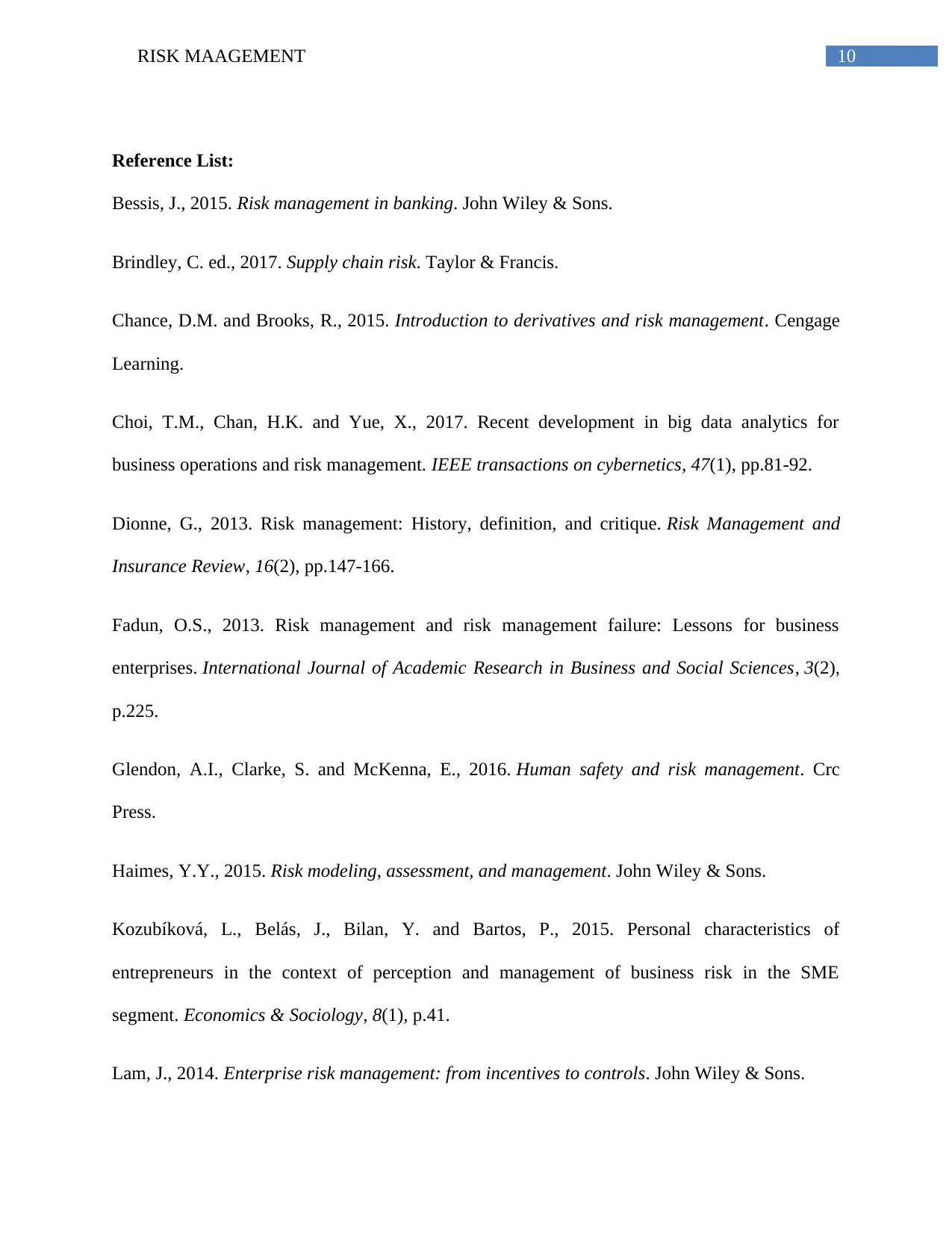
10RISK MAAGEMENT
Reference List:
Bessis, J., 2015. Risk management in banking. John Wiley & Sons.
Brindley, C. ed., 2017. Supply chain risk. Taylor & Francis.
Chance, D.M. and Brooks, R., 2015. Introduction to derivatives and risk management. Cengage
Learning.
Choi, T.M., Chan, H.K. and Yue, X., 2017. Recent development in big data analytics for
business operations and risk management. IEEE transactions on cybernetics, 47(1), pp.81-92.
Dionne, G., 2013. Risk management: History, definition, and critique. Risk Management and
Insurance Review, 16(2), pp.147-166.
Fadun, O.S., 2013. Risk management and risk management failure: Lessons for business
enterprises. International Journal of Academic Research in Business and Social Sciences, 3(2),
p.225.
Glendon, A.I., Clarke, S. and McKenna, E., 2016. Human safety and risk management. Crc
Press.
Haimes, Y.Y., 2015. Risk modeling, assessment, and management. John Wiley & Sons.
Kozubíková, L., Belás, J., Bilan, Y. and Bartos, P., 2015. Personal characteristics of
entrepreneurs in the context of perception and management of business risk in the SME
segment. Economics & Sociology, 8(1), p.41.
Lam, J., 2014. Enterprise risk management: from incentives to controls. John Wiley & Sons.
Reference List:
Bessis, J., 2015. Risk management in banking. John Wiley & Sons.
Brindley, C. ed., 2017. Supply chain risk. Taylor & Francis.
Chance, D.M. and Brooks, R., 2015. Introduction to derivatives and risk management. Cengage
Learning.
Choi, T.M., Chan, H.K. and Yue, X., 2017. Recent development in big data analytics for
business operations and risk management. IEEE transactions on cybernetics, 47(1), pp.81-92.
Dionne, G., 2013. Risk management: History, definition, and critique. Risk Management and
Insurance Review, 16(2), pp.147-166.
Fadun, O.S., 2013. Risk management and risk management failure: Lessons for business
enterprises. International Journal of Academic Research in Business and Social Sciences, 3(2),
p.225.
Glendon, A.I., Clarke, S. and McKenna, E., 2016. Human safety and risk management. Crc
Press.
Haimes, Y.Y., 2015. Risk modeling, assessment, and management. John Wiley & Sons.
Kozubíková, L., Belás, J., Bilan, Y. and Bartos, P., 2015. Personal characteristics of
entrepreneurs in the context of perception and management of business risk in the SME
segment. Economics & Sociology, 8(1), p.41.
Lam, J., 2014. Enterprise risk management: from incentives to controls. John Wiley & Sons.
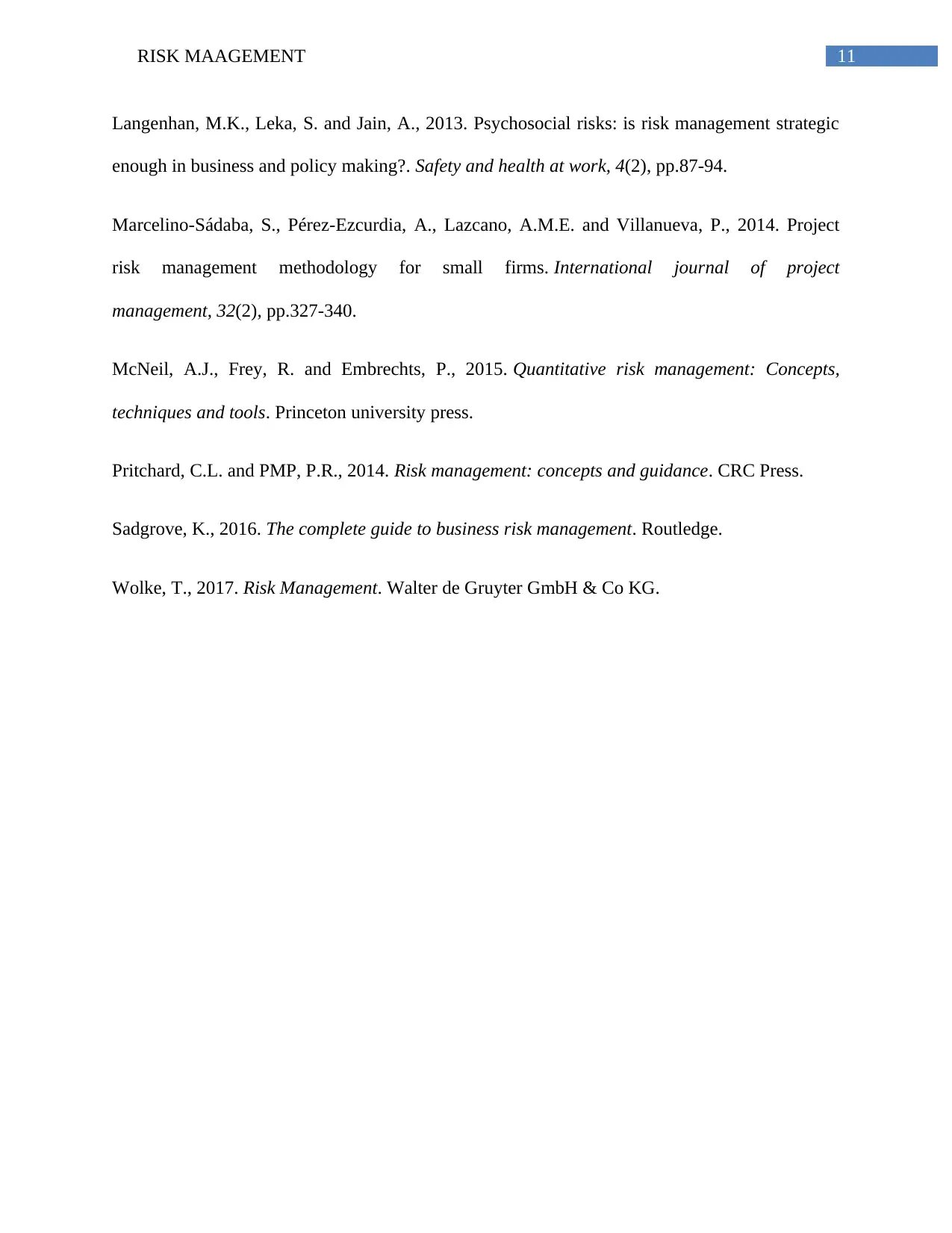
11RISK MAAGEMENT
Langenhan, M.K., Leka, S. and Jain, A., 2013. Psychosocial risks: is risk management strategic
enough in business and policy making?. Safety and health at work, 4(2), pp.87-94.
Marcelino-Sádaba, S., Pérez-Ezcurdia, A., Lazcano, A.M.E. and Villanueva, P., 2014. Project
risk management methodology for small firms. International journal of project
management, 32(2), pp.327-340.
McNeil, A.J., Frey, R. and Embrechts, P., 2015. Quantitative risk management: Concepts,
techniques and tools. Princeton university press.
Pritchard, C.L. and PMP, P.R., 2014. Risk management: concepts and guidance. CRC Press.
Sadgrove, K., 2016. The complete guide to business risk management. Routledge.
Wolke, T., 2017. Risk Management. Walter de Gruyter GmbH & Co KG.
Langenhan, M.K., Leka, S. and Jain, A., 2013. Psychosocial risks: is risk management strategic
enough in business and policy making?. Safety and health at work, 4(2), pp.87-94.
Marcelino-Sádaba, S., Pérez-Ezcurdia, A., Lazcano, A.M.E. and Villanueva, P., 2014. Project
risk management methodology for small firms. International journal of project
management, 32(2), pp.327-340.
McNeil, A.J., Frey, R. and Embrechts, P., 2015. Quantitative risk management: Concepts,
techniques and tools. Princeton university press.
Pritchard, C.L. and PMP, P.R., 2014. Risk management: concepts and guidance. CRC Press.
Sadgrove, K., 2016. The complete guide to business risk management. Routledge.
Wolke, T., 2017. Risk Management. Walter de Gruyter GmbH & Co KG.
⊘ This is a preview!⊘
Do you want full access?
Subscribe today to unlock all pages.

Trusted by 1+ million students worldwide
1 out of 12
Related Documents
Your All-in-One AI-Powered Toolkit for Academic Success.
+13062052269
info@desklib.com
Available 24*7 on WhatsApp / Email
![[object Object]](/_next/static/media/star-bottom.7253800d.svg)
Unlock your academic potential
Copyright © 2020–2025 A2Z Services. All Rights Reserved. Developed and managed by ZUCOL.





